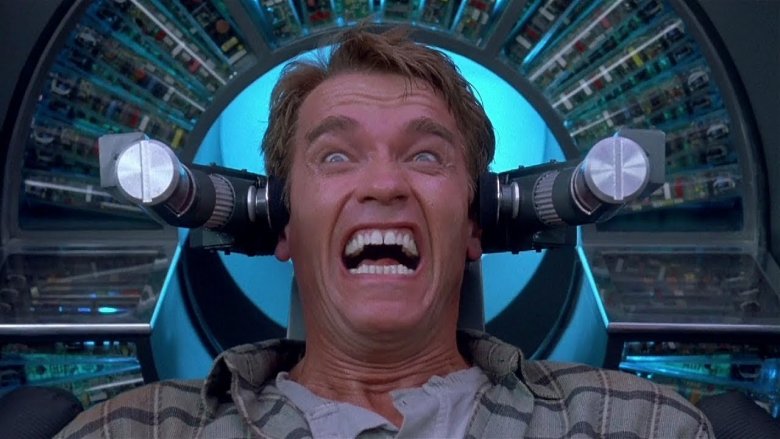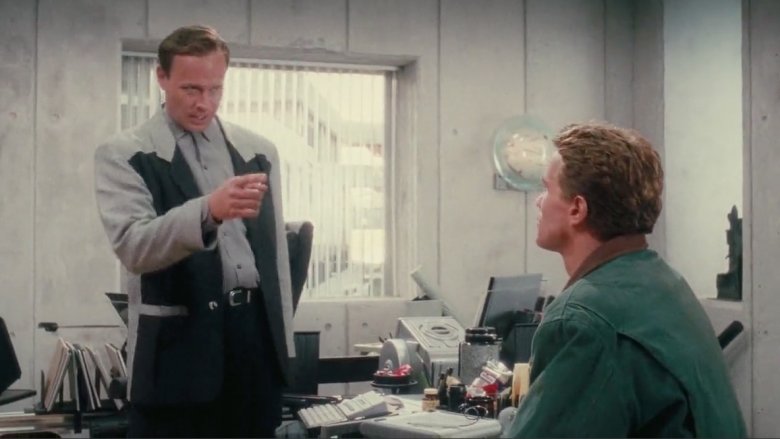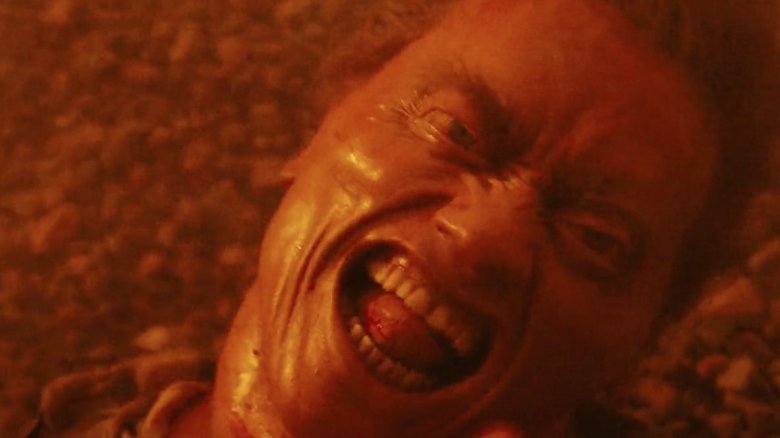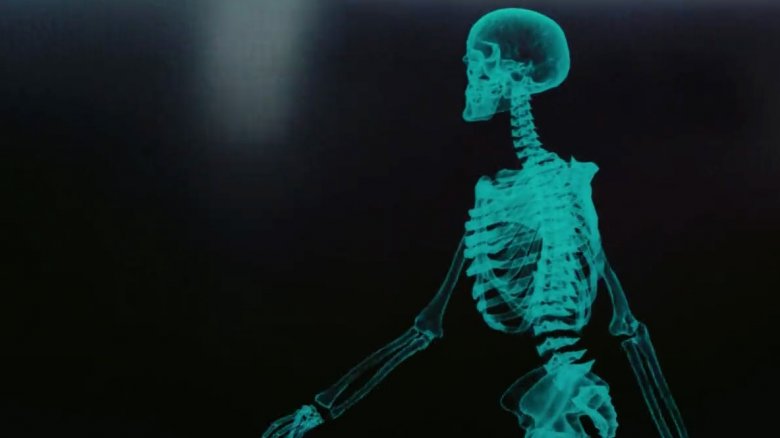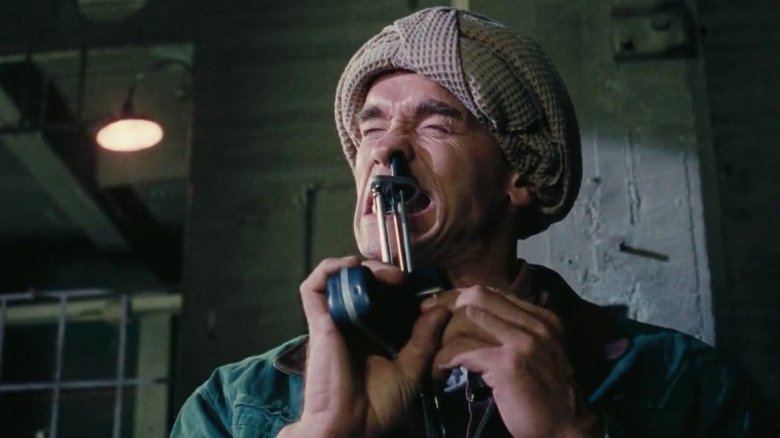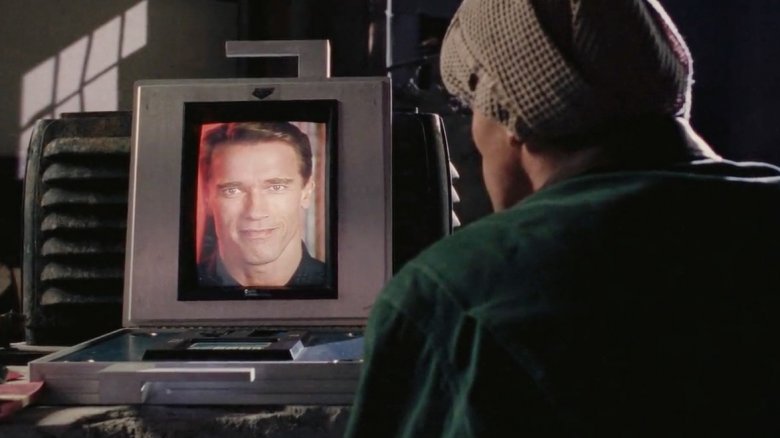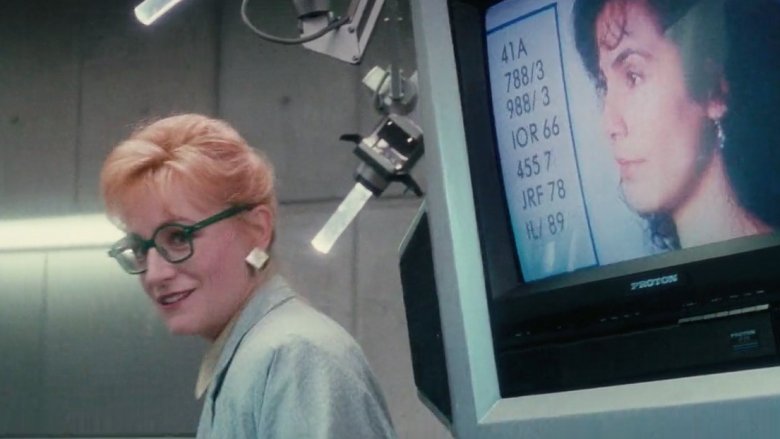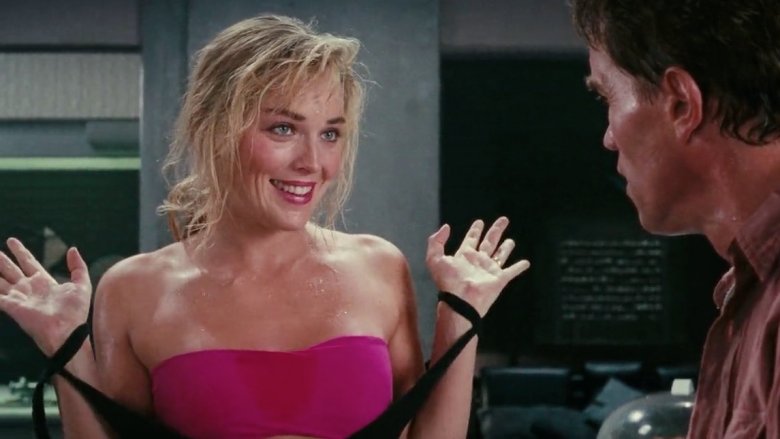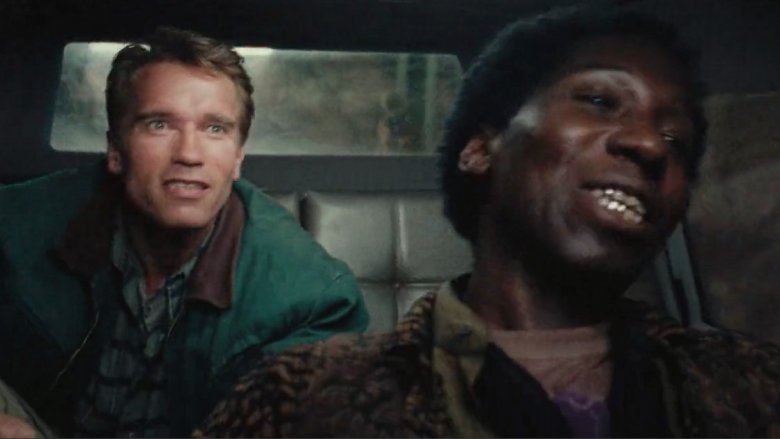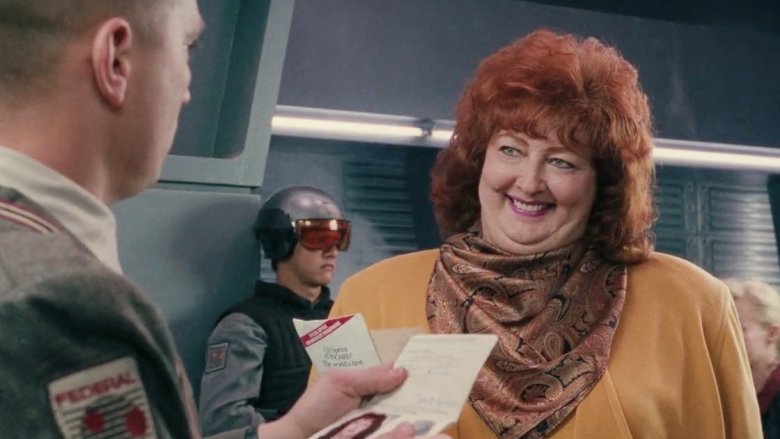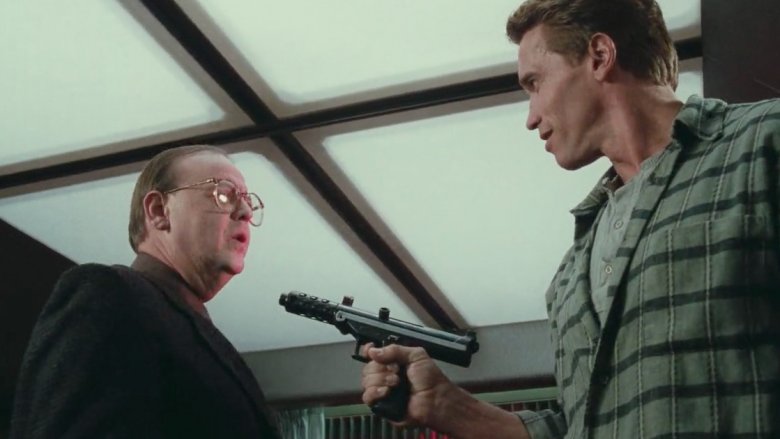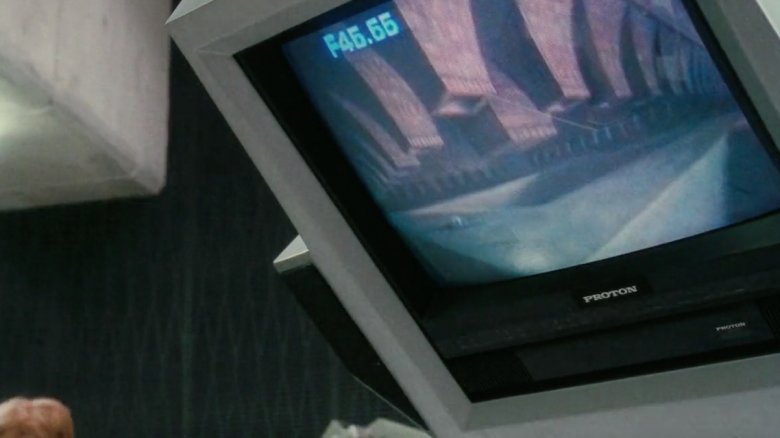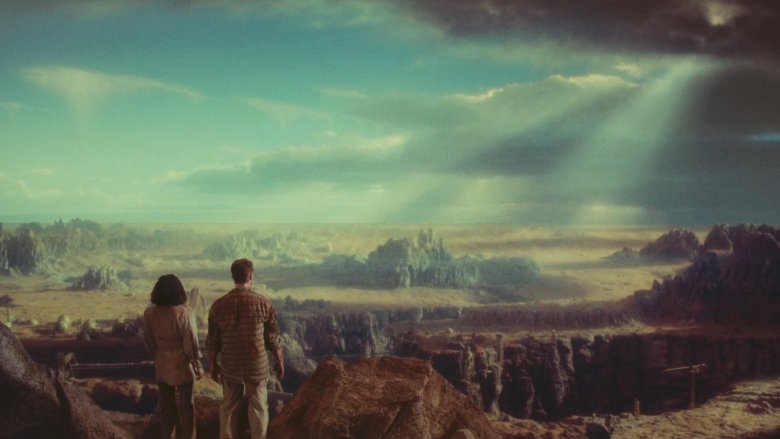The Ending Of Total Recall Explained
Total Recall is one of the most beloved science fiction films of the last few decades, perfectly meshing director Paul Verhoeven's high-octane sleaziness with sci-fi legend Philip K. Dick's original high-concept We Can Remember It For You Wholesale, all wrapped up in a tidy Austrian bow with the massive star power of an early '90s Arnold Schwarzenegger. Still, the movie's story of a secret agent buried deep undercover with conflicting loyalties (or maybe just a construction worker tired of his humdrum life dreaming of a better one) has led audiences to wonder about the enigmatic final scene: was Quaid dreaming, or was he actually a secret agent?
But fans don't need to subject themselves to scientists and untested dream procedures to figure out the ending—we've painstakingly combed the movie for all the clues you need for what's really happening as Douglas Quaid looks out across the Martian sky.
Most of Total Recall is a dream
One of the most confusing facets of the movie is that the plot of Total Recall identically mirrors the memory implants that Quaid himself requests from the Rekall organization. Quaid asks for the "Secret Agent" package, which goes as follows according the salesman: "You're a top operative working undercover on an important mission. People are trying to kill you left and right. You meet this beautiful exotic woman... You get the girl, kill the bad guys, and save the entire planet."
Coincidentally, Quaid realizes he was always a secret agent, gets the girl, and kills the bad guy, freeing Mars from capitalistic bondage.
Quaid appears to wake up before the implant is actually inserted, but the salesman is very specific about the realism of the implants, and how they trick the brain into thinking it's remembering real memories. Is Quaid dreaming, or just remembering his true self? The blurring of reality and dream continues throughout the movie, with multiple villainous characters begging him to question what he believes to be the truth.
Surprisingly, the villains are 100 percent correct. Quaid is dreaming, and the moment the camera cuts away from the start of the Rekall procedure, everything that follows is our visual impression of Quaid's dream.
In fact, many of the movie's plot elements are culled directly from innocuous moments embedded in those few opening scenes. The Rekall scientists even explicitly mention that they combine the base program with elements from the subject's real life to better create realistic memories.
The bulging eyes
We'll start at the beginning. Fittingly, the movie opens with a dream, as Quaid sees himself and a woman we'll later learn is Malina (Rachel Ticotin) on Mars in spacesuits. Quaid slips and falls down a hill and his helmet breaks, his eyes bulging out of his skull as he wakes up, ending the dream. At the end of the film, Quaid and Malina are sucked out into the atmosphere of Mars, and his eyes bulge out of his skull almost identically to the dream that started the movie.
As mentioned above, the scientists are culling Quaid's dreams for potent imagery, the better to match his subconscious desires with his Rekall-implanted memories. Even if Quaid is actually Hauser on a deep secret mission, it makes no sense for him to dream his own death in a way that looks identical to what actually happens. We don't even get a sense that this particular kind of death is common on Mars, as the residents have the good sense to stay indoors and breathe recycled air. Quaid's dreaming death scene is foreshadowing for the final action set piece on Mars, a viscerally effective image that the scientists used to make the Rekall sequence feel even more real.
The X-ray
This oft-overlooked detail is one of the strongest pieces of evidence that Quaid is dreaming. In the opening scenes prior to the Rekall procedure, he walks through an X-ray machine. We see his skeleton move smoothly through the box without alerting anyone of any hidden metals on his body. Later, after the Rekall procedure has begun and Quaid is running for his life, he passes through the X-ray machine again, this time setting off an alarm as it recognizes the metallic gun he's holding.
However, attentive viewers will remember that Quaid actually has a tracking chip buried in his cranium that he then has to remove to cast off his pursuers. The tracking chip is clearly made of metal, but didn't appear in the X-Ray, either before or after the Rekall procedure. Why not? Because Quaid hadn't yet gotten to that moment in his dream—the scientists used the memory of his stroll through the machine as an action set piece, but because Quaid didn't know at the time that he had a tracking chip, his subconscious mind doesn't bother to change the imagery of his skeleton.
Rippling anxiety
Early in the film, one of Quaid's co-workers from the construction company warns him not to go to Rekall—he heard someone was lobotomized there. Quaid ignores his warning; after the Rekall procedure, he discovers that his best friend is actually an undercover agent for the government tasked to keep Quaid unaware. But is he?
His warning about the possibility of a lobotomy echoes throughout the visual inspirations of the movie: when Quaid pulls out his tracker chip, he pushes a tool through his nasal cavity until he hears a "chunk," a strikingly similar process to original lobotomy procedures. Likewise, when the doctor shows up on Mars to tell Quaid he's having an adverse reaction to the Rekall procedure, he takes the tack of reminding Quaid of the possible side effects to the brain. When Cohaagen is planning to swap Quaid's memories with Hauser's, the terror of the scene is that Quaid's personality will be erased, a terror shared by similar horror stories of lobotomies. Even Quaid's eye-bulging near-death scene at the end of the movie can be read as the fear of a brain aneurysm. The oft-mentioned dangers of the Rekall procedure reverberate through the entire film.
Quaid and Hauser
When Quaid is discussing the Rekall procedure with the salesman Bob McClane (Ray Baker), McClane mentions their "special package." This process involves taking on a new identity (such as Olympic athlete, millionaire, or secret agent), and Quaid bristles against it. He still wants to be him, but he's tempted by the secret agent option. He eventually takes it once McClane goes through the plot of the movie (see above), but his initial discomfort at being someone else becomes sublimated into the Rekall procedure.
Quaid, as we find out later in the film, is also Hauser, a secret agent and one of Cohaagen's right-hand men. Quaid has to struggle against being re-implanted with Hauser's personality, perfectly mirroring his own discomfort with the Rekall procedure's multiple identities option. Quaid wanted to remain true to himself while still taking advantage of the "Secret Agent" module of the Rekall procedure, and that manifests in his battle with the "Hauser" personality. "Hauser" allows him to be both a secret agent deep undercover while still remaining the same person he was before being woken up from that deep cover.
Malina
Malina is the mysterious woman who first appears in Quaid's dream that opens the film. She's given no dialogue or personality, just a face in an astronaut's suit. Later, when Quaid goes to Rekall, they ask him to describe his perfect woman, encouraging him to be as honest as possible to have "more fun" in the implanted memories. Quaid describes a woman who is "brunette... athletic... sleazy and demure," and before he passes out he sees that the scientists are sculpting Malina's face.
We know from the beginning that the scientists are combing through Quaid's dreams to better fit him for an implant—while Malina's face appearing on the televisor could be interpreted as Quaid's hallucination, we know it to be a product of the scientists' technology. Malina herself, as we later find, works in a brothel, is athletic, and is both demure and sleazy. She perfectly matches the personality type Quaid wants to appear in his Rekall memories.
Lori
Lori (Sharon Stone), Quaid's wife, is against Rekall and Mars altogether. When Quaid is enacting his secret agent fantasy, he imagines her as a mole for Cohaagen. That he positions her as the villain when she's so against him wasting money on a dangerous procedure (Rekall) or a vacation to a war zone (Mars) makes perfect sense. Her convenient secret marriage to Cohaagen's lieutenant Richter (Michael Ironside) allows Quaid to freely pursue Malina without having to worry about any sort of guilt for breaking his marriage vows. As an added bonus, she consistently compliments his masculinity and sexual prowess—even when she's an enemy, Quaid can't help but use her to prop up his own ego.
The crooked cabbie
When the sales agent boasts to Quaid that Rekall implants are better than a regular vacation, he lists a litany of annoyances that their service avoids, and one of them is the issue of "crooked cabbies" ruining a vacation. When Quaid is on Mars later in the film, he runs into Benny (Mel Johnson Jr.) a cabbie that drives him into the red light district; Quaid finds out Benny has a deal with a specific establishment that gives him a cut of the profits if he brings tourists there.
But that's not all—later in the film, Benny is revealed as a double agent for Cohaagen, tasked with discovering the secret mutant freedom fighters' lair. Benny, then, is a crooked cabbie twice over, a subconscious trigger that Quaid uses to fill out his dreamscape while within the Rekall procedure. Benny's presence also serves as a balm for Quaid's worried mind—if this were a "real" Rekall procedure, then there wouldn't be any crooked cabbies, just like McClane explained earlier in the film. By the time Quaid reaches Mars, his mind has started to protect him from the possibility that the Rekall procedure is going very wrong.
The malfunctioning robot disguise
One of the selling points of the Rekall procedure is that the implanted memories sync up to two weeks of perceived time. It's as if the patients spend an entire fortnight at the destination of their choosing.
When Quaid sneaks through the Martian Customs Office in a robotic disguise as a large, older woman, the ticket officer asks how long the trip is for. The robot (which conveniently breaks down in the most narratively satisfying moment) malfunctions when asked for more specificity than "two weeks." Two weeks was how long the Rekall procedure was supposed to last, but as we'll show in our next point, the malfunctioning robot has a point. It's not quite two weeks anymore, but how long it will last is anyone's guess.
Dr. Edgemar's prediction
Lori shows up for the final time when Quaid is confronted by Dr. Edgemar (Roy Brocksmith), who warns Quaid he's in danger of suffering a schizoid embolism, and he's trapped within the dream. He says he and Lori, the real actual Mrs. Quaid, have gone into Quaid's fantasy to pull him out before further damage occurs. He also tells Quaid he's suffering a schizoid embolism that will leave his mind jumbled unless Quaid accepts their help. He warns Quaid that the Rekall fantasy will become jumbled, that the "walls of reality will break down...One minute, you're the savior of the rebel cause; next thing you know, you'll be Cohaagen's bosom buddy. You'll even have fantasies about alien civilizations as you requested; but in the end, back on Earth, you'll be lobotomized!"
Quaid thinks Edgemar is a plant and shoots them both, but the doctor is right: the walls (of the hotel) literally break down as Cohaagen's men burst in. In the next scene, Kuato is murdered, leaving Quaid as the leader of the rebellion, just as Cohaagen bursts in to deliver the news that Quaid is actually Hauser, his right-hand man. The doctor's prediction was exactly right.
Blue sky on Mars
As the scientists are preparing Quaid for the Rekall procedure in the beginning of the film, one of them notices something odd in Quaid's dreams. He tells the other lab worker, "Blue sky on Mars. That's interesting." He's referring to the blue sky that ends the film, just as Quaid wonders if he's actually dreaming. And he is: the scientists have never heard of a blue sky on Mars before they put Quaid under, and their acknowledgement of its significance is what allows them to create a soothing ending for Quaid's Rekall dream.
Alien artifacts
Likewise, in the lab scene, the secret arc reactor/alien artifact can be spotted flashing across the screen before Quaid's put under. One of the scientists also makes the observation that "It's all about alien artifacts these days." It makes no sense for the Rekall offices to actually have access to the top-secret alien artifact that Cohaagen has spent untold amounts of money to keep secret.
It appears on the monitor because it's part of Quaid's dreaming package, and they're prepping the operation. Verhoeven himself backed that up on the DVD commentary, saying, "All the images of the tubes that you just saw are of course the tubes that you see at the end of the movie when the nuclear reactor starts."
Paul Verhoeven thinks it was a dream
But if all the above words don't convince you, then maybe the the director's words will. Paul Verhoeven lays out the clues that point to the dream interpretation on the DVD commentary of the movie, starting at the moment that Quaid drifts off to sleep after seeing Malina's face on the monitor.
"Be aware that if everything that happens in the movie from now on is going to be a dream, if there is no reality to anything ... realize that the dream really starts at the moment that he falls asleep. So the next scene, which seems to be a f***-up of the machine, is part of the dream," says Verhoeven. "So this is the last moment of his reality. Goes into the unconsciousness, and basically from now on...boom! The dream starts. ... That's the trick of the company, that they make a dream that's so convincing that it seamlessly goes from the first reality into the second one."
